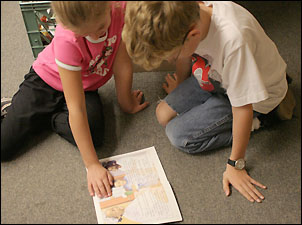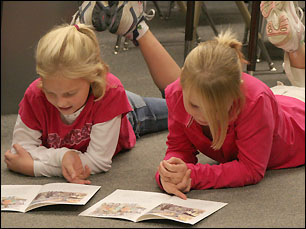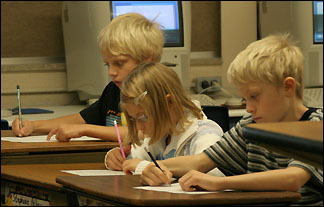Looping classroom starts second year at elementary school
 Third grade teacher Ross Englestad - in his second year with a looping class that he also taught last year as second graders - meanwhile put a math problem on the overhead the first day of school and purposely left the room. His students remembered to start working on the problem in their math notebook without instruction.
Third grade teacher Ross Englestad - in his second year with a looping class that he also taught last year as second graders - meanwhile put a math problem on the overhead the first day of school and purposely left the room. His students remembered to start working on the problem in their math notebook without instruction.
Third graders Heather Arnold and Ethan Bryant read a book together.
By remembering what to do when faced with that problem of the day, Englestad's students illustrated one of the advantages of looping: being ready to get right into the curriculum the second year. "You're 32 days ahead as far as (the problem of the day) goes," said Hengel.
The goal of looping was familiarity with the teacher (both teaching style and classroom rules and routines), familiarity with students (knowing strengths and weaknesses, etc.), and familiarity between teacher and parents (helping communication). Englestad had 25 students in his second grade class last year and has 24 students this year. (Two students moved out of the district, and one new student joined the class.) Hengel has 23 students in her second grade class.
Participation in the looping class is voluntary. Parents must opt to have their child participate. Because demand has been greater than the class size in both years so far, a lottery was held to decide which students to include.
Englestad did do a brief review of his classroom routine and rules this fall, and his students still need reminders, he said, but in general they have been able to focus more on the content since the setting is so familiar, he reported.
 "I thought it went really well," said Englestad. "Kids knew where everything was in the classroom. Kids knew the routines."
"I thought it went really well," said Englestad. "Kids knew where everything was in the classroom. Kids knew the routines."
Third graders Teirrah Syvertson and Kaitlin Haase make themselves comfortable while reading a book for accelerated reading in the looping class.
Reminding students to put their name on their paper, to number their problems, to keep their hands to themself in line, etc., does take time, said Hengel. "He was able to dig right into his subject area," she said.
One parent of a third grader in the looping classroom for a second year said her daughter is typically reserved and didn't really get comfortable in first grade until Christmas. She and her husband chose the looping classroom because they felt the same environment for two years would help their daughter.
Another parent said her daughter had much less anxiety this fall returning to a teacher and classroom that she already knew. "Typically, she is the type of child who suffers from anxiety at the start of the school year. She worries about whom the teacher is, who will be in her classroom, who she'll sit by, etc.," said the parent. "This year, she didn't express the same apprehension. It was much easier as a parent knowing that your child was confident starting the new year."
"By having the same teacher (in the same physical location), the behavioral expectations were already understood. The students already knew the rules according to Mr. Engelstad. In my opinion, much time is saved with this alternative. The teacher knows the students, and vice versa. Personalities are already identified, as well as abilities and learning levels," she continued.
Hengel saw that Englestad's class was very relaxed this fall because of their familiar environment.
Another reason why Englestad's students were more prepared to jump right into the curriculum is because he assigned homework over the summer.
"Oh, man, I didn't like that," said third grader Ethan Brown of the homework assignment. "Because I had to do it at the last minute."
Classmate Heather Arnold said she forgot about the homework until the last month, too, but she said it was helpful to remember things they had done in second grade and prepare them for school this year.
The summer homework was not overwhelming, said one parent, and it minimized necessary review time.
"The summer homework was a welcome expectation in my opinion," said another parent. "It wasn't too heavy, so it didn't become a burden to complete. However, it did help my daughter retain math facts and encouraged her to work on writing. Again, this may have proven to be a time-saving method. I'm sure the students were introduced to the third grade curriculum with much less time spent on review."
 Knowing his students helps to know what they are capable of doing and what strategies are effective in helping them, said Englestad. "I knew when they walked into the open house: this is what I need to work on with this student," he said.
Knowing his students helps to know what they are capable of doing and what strategies are effective in helping them, said Englestad. "I knew when they walked into the open house: this is what I need to work on with this student," he said.
Third graders Hunter Voss, Stephanie Pelkey, and Logan Lahr take a spelling test in Ross Englestad's Loopers classroom.
Englestad also reported that he knows the parents of his students much better to start this year, which makes them much more likely to send e-mails and to address issues early, instead of waiting until they grow into bigger problems. "I've enjoyed the fact that I know the parents this year," he said.
In most classrooms, by the time you actually get to know parents really well, it's the end of the school year, said Hengel.
Participation in the looping classroom is voluntary, and one parent understands why parents might not choose this option. She and her husband thought it was the right option for their more reserved daughter, but it might not be for their son. Besides, there are "so many good teachers" at PAES that looping minimizes the variety he would have. They also are concerned about his need to develop a wide circle of friends.
For the teachers, embracing the looping classroom means teaching the second grade curriculum and then the third grade curriculum. There is a difference, Englestad and Hengel reported. Third grade involves higher expectations and more advanced skills. For instance, in second grade, students are still polishing their reading skills, but in third grade, they are expected to use them to read for content.
Englestad - who had taught second grade at PAES for four years, including the looping class last year, but had taught third grade at Willmar previously - said his big worry about the curriculum this year was to challenge his third grade students enough.
Hengel, who switched to the looping classroom after five years of teaching kindergarten, said it's a good challenge to teach a different grade and it's a good opportunity to work with Englestad. Hengel taught second grade as part of her student teaching. She was surprised when her second graders could put their backpacks away, sit at their desks, and be ready for her to start teaching on the first day of school this year and has high hopes that these benefits will continue in the second year of looping.
Englestad and Hengel agreed that looping is not a new concept. It has been used for years in the high school, where teachers teach the same students in different grades. And it was used for years in country schools. The new K-1 multi-age classrooms at PAES is also a form of looping, they noted, only these classes have both kindergarten and first grade students. The kindergartners will stay in the class as first graders next year.
The looping classroom has been so successful that it will be tough for the students to leave this spring, predicted one parent. "The last day of school will certainly be one full of tears as the students have to say goodbye to one another and Mr. Engelstad," she said.
Contact the author at editor@paynesvillepress.com • Return to News Menu
Home | Marketplace | Community